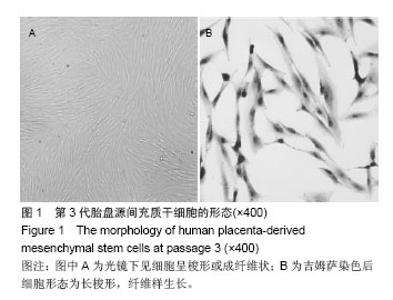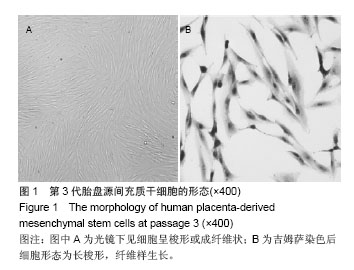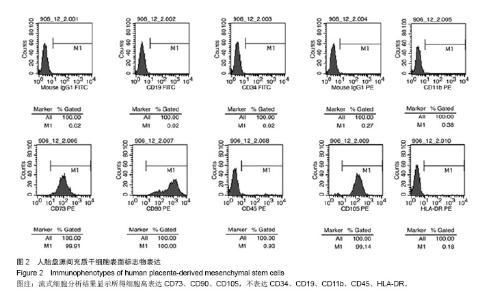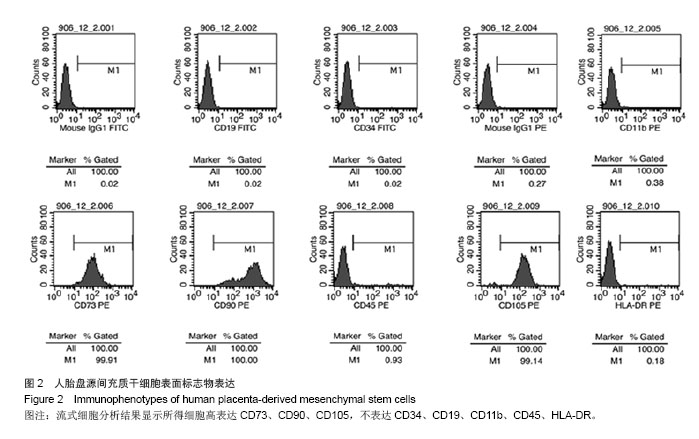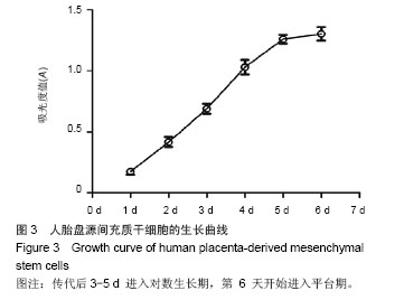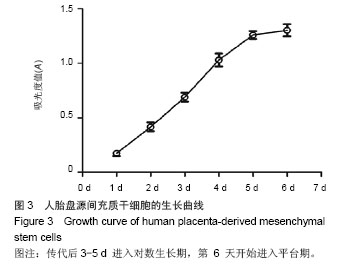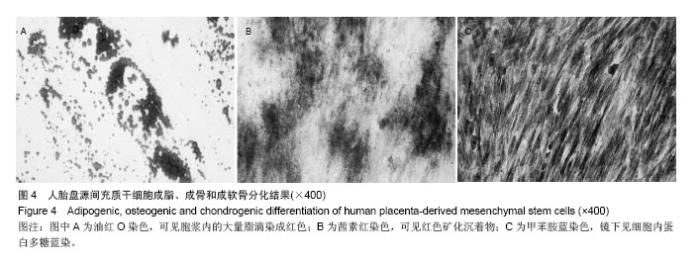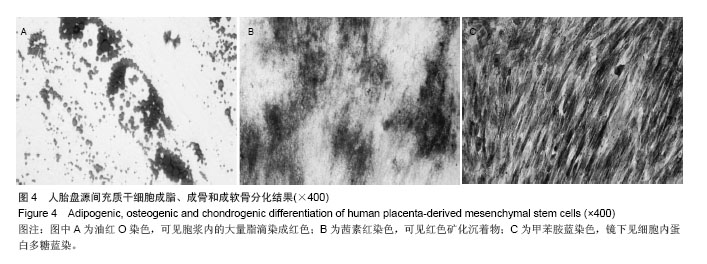| [1]Battula VL, Bareiss PM, Treml S,et al. Human placenta and bone marrow derived MSC cultured in serum-free, b-FGF-containing medium express cell surface frizzled-9 and SSEA-4 and give rise to multilineage differentiation. Differentiation. 2007;75(4):279-291.
[2]Karp JM, Leng Teo GS.Mesenchymal stem cell homing: the devil is in the details.Cell Stem Cell. 2009;4(3):206-216.
[3]Takashima Y, Era T, Nakao K, et al. Neuroepithelial cells supply an initial transient wave of MSC differentiation. Cell. 2007;129(7):1377-1388.
[4]Caplan AI. All MSCs are pericytes. Cell Stem Cell. 2008; 3(3):229-230.
[5]Parekkadan B, Milwid JM. Mesenchymal stem cells as therapeutics. Annu Rev Biomed Eng. 2010;12:87-117.
[6]Zhang X, Mitsuru A, Igura K, et al. Mesenchymal progenitor cells derived from chorionic villi of human placenta for cartilage tissue engineering. Biochem Biophys Res Commun. 2006;340(3):944-952.
[7]Kanematsu D, Shofuda T, Yamamoto A, et al. Isolation and cellular properties of mesenchymal cells derived from the decidua of human term placenta. Differentiation. 2011;82(2): 77-88.
[8]Feng X, Xing J, Feng G, et al. p16(INK4A) mediates age-related changes in mesenchymal stem cells derived from human dental pulp through the DNA damage and stress response. Mech Ageing Dev. 2014;141-142:46-55.
[9]Haynesworth SE, Goshima J, Goldberg VM, et al. Characterization of cells with osteogenic potential from human marrow. Bone. 1992;13(1):81-88.
[10]Deng B, Wen J, Ding Y, et al. Different regulation role of myostatin in differentiating pig ADSCs and MSCs into adipocytes. Cell Biochem Funct. 2012;30(2):145-150.
[11]Jin J, Wang J, Huang J, et al. Transplantation of human placenta-derived mesenchymal stem cells in a silk fibroin/hydroxyapatite scaffold improves bone repair in rabbits. J Biosci Bioeng. 2014;118(5):593-598.
[12]Luan X, Li G, Wang G, et al. Human placenta-derived mesenchymal stem cells suppress T cell proliferation and support the culture expansion of cord blood CD34? cells: a comparison with human bone marrow-derived mesenchymal stem cells. Tissue Cell. 2013;45(1):32-38.
[13]Vellasamy S, Sandrasaigaran P, Vidyadaran S, et al. Mesenchymal stem cells of human placenta and umbilical cord suppress T-cell proliferation at G0 phase of cell cycle. Cell Biol Int. 2013;37(3):250-256.
[14]Parolini O, Caruso M. Review: Preclinical studies on placenta-derived cells and amniotic membrane: an update. Placenta. 2011;32 Suppl 2:S186-S195.
[15]Robin C, Dzierzak E. Preparation of hematopoietic stem and progenitor cells from the human placenta. Curr Protoc Stem Cell Biol. 2010;Chapter 2:Unit 2A.9.
[16]Robin C, Bollerot K, Mendes S, et al. Human placenta is a potent hematopoietic niche containing hematopoietic stem and progenitor cells throughout development. Cell Stem Cell. 2009;5(4):385-395.
[17]Patel J, Shafiee A, Wang W, et al. Novel isolation strategy to deliver pure fetal-origin and maternal-origin mesenchymal stem cell (MSC) populations from human term placenta. Placenta. 2014;35(11):969-971.
[18]李艳琪,王洪一,姚尧,等.人脐带源间充质干细胞分离培养方法的改进[J].中国组织工程研究,2014,18(10):1609-1614.
[19]Joe IS, Jeong SG, Cho GW. Resveratrol-induced SIRT1 activation promotes neuronal differentiation of human bone marrow mesenchymal stem cells. Neurosci Lett. 2015;584: 97-102.
[20]Li K, Li SZ, Zhang YL, et al. The effects of dan-shen root on cardiomyogenic differentiation of human placenta-derived mesenchymal stem cells. Biochem Biophys Res Commun. 2011;415(1):147-151.
[21]Ni L, Liu X, Sochacki KR, et al. Effects of hypoxia on differentiation from human placenta-derived mesenchymal stem cells to nucleus pulposus-like cells. Spine J. 2014; 14(10): 2451-2458.
[22]Yi JK, Mehrazarin S, Oh JE, et al. Osteo-/odontogenic differentiation of induced mesenchymal stem cells generated through epithelial-mesenchyme transition of cultured human keratinocytes. J Endod. 2014;40(11):1796-1801.
[23]Gharibi B, Ghuman MS, Hughes FJ. Akt- and Erk-mediated regulation of proliferation and differentiation during PDGFRβ-induced MSC self-renewal. J Cell Mol Med. 2012; 16(11):2789-2801.
[24]Li N, Pan S, Zhu H, et al. BMP4 promotes SSEA-1(+) hUC-MSC differentiation into male germ-like cells in vitro. Cell Prolif. 2014;47(4):299-309.
[25]Yu S, Tajiri N, Franzese N, et al. Stem cell-like dog placenta cells afford neuroprotection against ischemic stroke model via heat shock protein upregulation. PLoS One. 2013;8(9): e76329.
[26]Kong P, Xie X, Li F, et al. Placenta mesenchymal stem cell accelerates wound healing by enhancing angiogenesis in diabetic Goto-Kakizaki (GK) rats. Biochem Biophys Res Commun. 2013;438(2):410-419.
[27]Zhu SF, Zhong ZN, Fu XF, et al. Comparison of cell proliferation, apoptosis, cellular morphology and ultrastructure between human umbilical cord and placenta-derived mesenchymal stem cells. Neurosci Lett. 2013;541:77-82.
[28]Cheng CC, Chung CA, Su LC, et al. Osteogenic differentiation of placenta-derived multipotent cells in vitro. Taiwan J Obstet Gynecol. 2014;53(2):187-192.
[29]Wang CH, Wu CC, Hsu SH, et al. The role of RhoA kinase inhibition in human placenta-derived multipotent cells on neural phenotype and cell survival. Biomaterials. 2013; 34(13): 3223-3230.
[30]万振洲,冯亚松,彭海林,等.体外诱导胎盘间充质干细胞向表皮细胞的分化[J].中国组织工程研究与临床康复, 2011,15(49): 9225-9226. |
